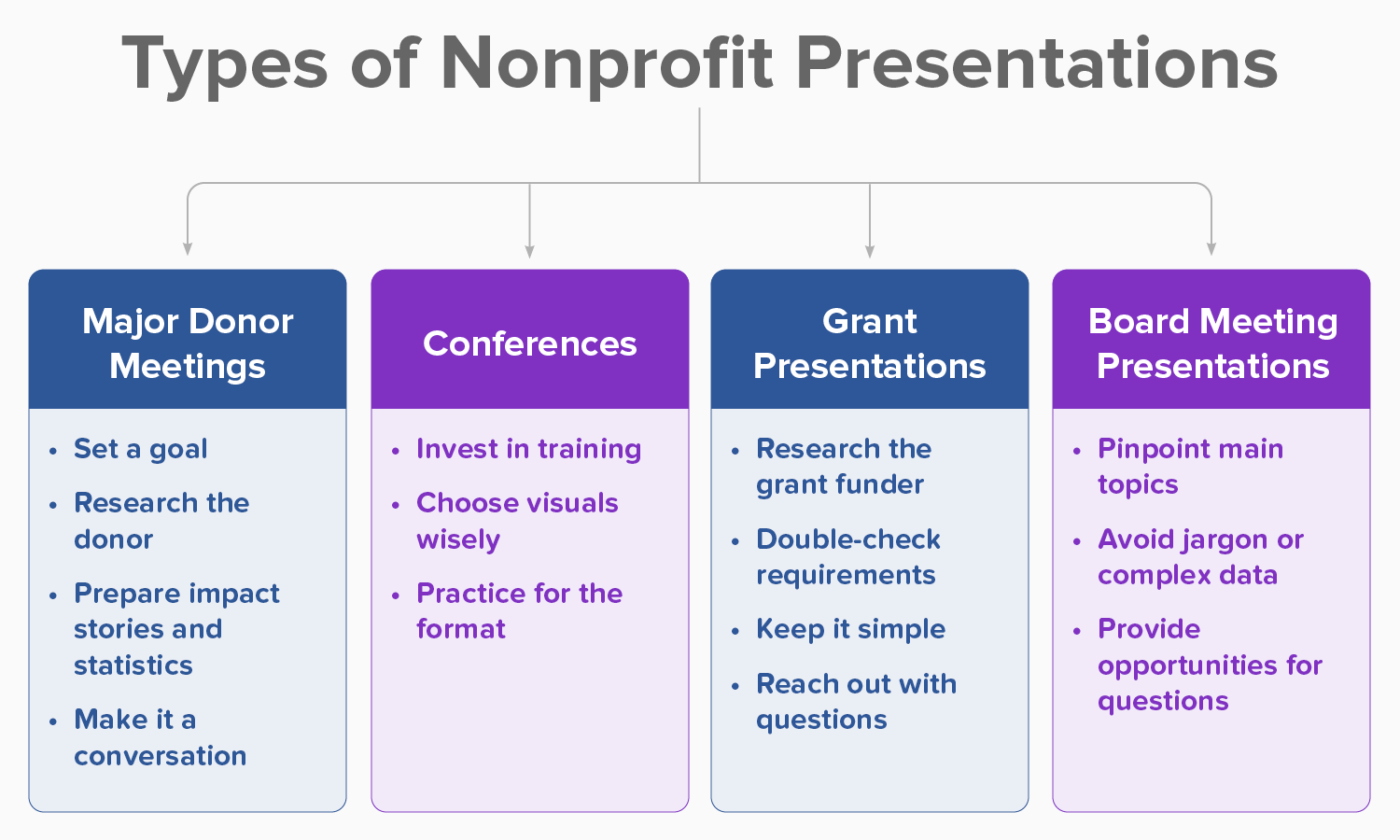
As a nonprofit professional, you might not consider public speaking to be one of your primary job responsibilities. However, many of your daily activities probably fall under the umbrella of public speaking. Interacting with donors, grant funders, board members, and other stakeholders requires clear, concise communication.
That’s why it’s important to build strong presentation skills. When you can effectively communicate your organization’s mission to a variety of audiences, you can secure more committed, long-lasting support for your cause.
Whether you’re looking to increase your nonprofit’s revenue through productive donor meetings or successfully communicate internal changes within your organization, we’ll highlight four common types of nonprofit presentations and some tips to leave a lasting impression on your listeners.

In this post, we’ll highlight four common types of nonprofit presentations and steps to prepare for them:
1. Major donor meetings
Major donors typically provide the bulk of a nonprofit’s funding, despite making up only a small percentage of its total donors. Because they contribute significant gifts, it’s important to spend time cultivating strong relationships with these supporters.
Major donor meetings are part of that stewardship process, providing an opportunity for your organization to make your case and convey why your nonprofit deserves support.
As you plan your major donor presentation, follow these steps:
- Set a goal for the meeting. If you’ll be asking for a donation, you might set a goal to have your prospective donor respond positively to your ask. If you’re using the meeting to get to know the donor more, you might set a goal to learn more about their philanthropic history and invite them to an upcoming event.
- Research the donor ahead of time. Use your donor management software and other external data resources (like social media) to find out more about your prospective donor. Look for information such as their past philanthropic involvement, charitable giving, and wealth. This research will give you talking points during the meeting and help you make a more informed donation request.
- Prepare impact stories and statistics. Before they choose to give, major donors want to know that their funds will lead to an actual, substantial impact on the community. Build their trust by demonstrating how you’ve made a difference in the lives of those you serve. Pull a few compelling stories and statistics to share during your presentation, such as the number of people you’ve helped or the amount of resources you’ve provided.
- Make your presentation a conversation. While sharing information about your nonprofit is important, the presentation should be a two-way street. Ask prospective donors about their interests, personal philanthropic goals, and motivations. This makes your presentation feel less like a quest to receive a donation and more like a genuine conversation.
Send thank-you messages to prospects who donate and share updates on how you’re putting their gifts to good use. For those who decide not to give during your meeting, respect their decision and ask if they’d like to continue receiving communications from your organization. Invite them to learn more about your cause or attend another meeting at a later date.
2. Conferences
Major nonprofit conferences allow you to introduce your organization’s mission to a wider audience. You might share insights into challenges you’ve faced, innovative projects you’ve undertaken, or other advice you have for fellow nonprofit professionals.
Use these tips to prepare ahead of a conference:
- Participate in conference speaker training. There are many experts dedicated to supporting the success of nonprofit professionals in key areas such as management training and public speaking. Tap into the latest tips and best practices by enrolling in guided training that will reduce your anxiety on the conference day and help you prepare effectively for your presentation.
- Choose visuals wisely. If you have the opportunity to display visuals during your presentation, choose them wisely. Any images or video clips you include should supplement your speech, not distract from it. A good rule of thumb is to stick to just a handful of engaging, simple visuals as presentation aids to keep distractions at a minimum.
- Practice for the presentation format. If you’re speaking at an in-person conference, see if you can practice your presentation in the venue before it’s time to deliver it. If you’re preparing for a virtual conference, record yourself giving your speech on your laptop camera. Pay special attention to your body language and your video background to ensure you present a polished appearance.
Make your conference presentation even more engaging by polling your audience members or asking for a volunteer to help demonstrate a concept. Getting your audience members involved in your presentation will make your speech more memorable and bring greater awareness to your mission.
3. Grant presentations
Most grant applications are written documents that your nonprofit fills out to receive funding from the government, foundations, or corporations. However, some grant funders might request a presentation along with your written statement.
Use these tips to simplify your planning process:
- Research the grant funders ahead of time. Funders want to support organizations that align with their values and mission. Just as when you’re trying to secure corporate sponsorships, conduct research into the grant funder to understand what types of organizations they’ve supported in the past and how you can design your presentation to align with their interests.
- Double-check all presentation requirements. As you craft your presentation, ensure it follows all of the grant funder’s requirements. For instance, you may have a time limit you should practice staying under or a specific order in which you need to present your content.
- Keep your presentation simple and to the point. Be respectful of the funder’s time by making your presentation concise. Highlight the one main goal you’re hoping to achieve with the help of the grant funding. Then, use specific data points to back up your proposal.
- Reach out to the funder with any important questions. By cultivating meaningful relationships with grant funders, your nonprofit can pave the way for a successful application and better outcomes for your future grant-seeking efforts. Contact the funder to clarify any unclear presentation requirements and start strengthening your connection with them.
Grants are competitive. Proper preparation can help you stand out from other organizations and prove to the funder that awarding the grant to your nonprofit would be the best investment for them to make.
4. Board meeting presentations
Strong presentation skills can improve alignment within your nonprofit, whether you’re working with other staff, volunteers, or board members. There will be occasions when you’ll need to meet with the board to share campaign updates or present a new strategy for their approval.
To set your presentation up for success, keep these tips in mind:
- Pinpoint one or two main topics to cover. Your board members lead busy lives, so be mindful of their time and only cover need-to-know information, whether you’re reviewing your strategic plan progress or trying to secure buy-in for new software.
- Avoid jargon or complex data. Your board members may not be well-versed in the complexities of your nonprofit’s data. Use infographics to present your data as clearly and simply as possible.
- Provide opportunities to ask questions. Make sure each board member walks away with a clear understanding of the information covered in your presentation. Give them the chance to ask questions and let them know who they should speak to if they have additional questions outside the meeting.
After your presentation, remember to thank the board for their time and attention. eCardWidget cites board member appreciation as a key contributor to a healthy organizational culture. While a presentation may feel one-sided at times, you’ll need everyone’s collective effort to push goals forward at your nonprofit.
Building public speaking skills allows you to advance your nonprofit’s mission more effectively and become a better ambassador for your cause. If you’re planning to invest in outside help with your presentation, Laridae’s nonprofit consultants guide recommends finding an expert who has extensive experience working with organizations similar to yours. They’ll already have a clear understanding of your goals, needs, and how to best appeal to your audience.
With a thoughtful, confident approach, you’ll be well-equipped for any type of nonprofit presentation you need to give, whether you’re meeting with a potential major donor, speaking at a fundraising event, or sharing information with your board members.
